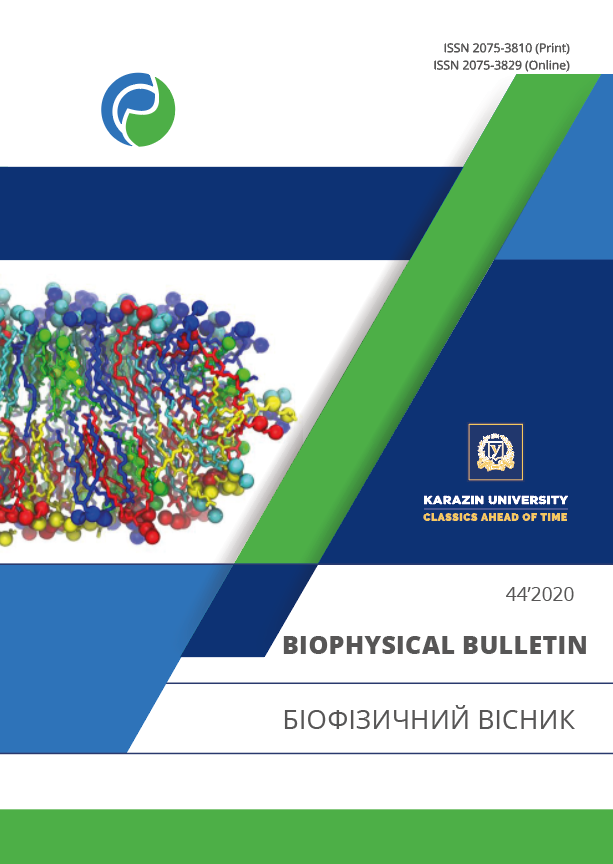FT-IR дослідження наявності органічних та бiогенних компонентів у ґрунті з об’єктів мiста Новгород-Сіверського
Анотація
Актуальність. Біофізичні методи дослідження як потужний інструмент для вивчення малих кількостей зразків, успішно застосовуються в суміжних галузях — судовій медицині, сільському господарстві, археології. Фізико-хімічні, зокрема спектроскопічні методи, застосовуються для датування, дослідження кераміки та складу артефактів з археологічних об’єктів. Використання інфрачервоної спектроскопії у археологічних дослідженнях зумовлене можливістю неруйнівного аналізу артефактів, легкою пробо підготовкою та високою чутливістю й дозволяють доповнити історичну реконструкцію. Завдяки тому, що антропогенні процеси, які відбувались у відповідному місці, відображаються у складі ґрунту, є актуальним дослідження ґрунту з об’єктів розкопок.
Мета роботи — встановлення наявності органічних решток в ґрунті з об’єкту археологічних розкопок та ідентифікація органічних молекул.
Матеріали і методи. Об’єкт дослідження — ґрунт з 3-х різних об’єктів (2 споруди та канава), що були ідентифіковані у межах одного розкопу міста Новгород-Сіверський Чернігівської області. Об’єкти за попередніми даними є давньоруськими. Було досліджено фізико-хімічні властивості відібраного ґрунту та проведено спектроскопічні дослідження з метою встановлення наявності низько- та високомолекулярних сполук у матеріалі.
Результати. Було визначено, що рівень рН досліджуваних зразків коливається від слабко кислого до лужного. При цьому рН материнської породи має слабко лужне значення. Методом FT-IR спектроскопії у зразках ґрунту із місця 1 та 2 (споруди) виявлено ДНК, протеїни, а у місці №2 ще й ліпіди. У канаві (№3) наявні тільки білки. Натомість у материнській породі спостерігались лише мінеральні компоненти. При мікроскопіюванні зразків ґрунту було виявлено, що піщинки із канави (№3) мають заокруглену форму. Також при мікроскопіюванні у зразках із місця №2 було виявлено рештки деревного вугілля.
Висновки. Наявність органічних компонентів у досліджуваних ґрунтах може бути результатом проживання та тривалої діяльності людей. Наявність у зразках №2 решток деревного вугілля та ідентифікованих молекул ліпідів може свідчити про те, що це місце було пов’язане з приготуванням їжі. При цьому, ґрунт із місця № 3 (канава) є збідненим на органічні рештки, а піщинки, що мають заокруглену форму, можуть вказувати на те, що у цьому місці тривалий час був контакт із водою.
Завантаження
Посилання
Lettiery M, Giannotta MT. Investigations by Ft-Ir Spectroscopy on Residues in Pottery Cosmetic Vases from Archaeological Sites in the Mediterranean Basin. Int J Exp Spectrosc Tech. 2017;2(1):1–10. https://doi.org/10.35840/2631-505X/8509
McGovern PE, Hall GR. Charting a Future Course for Organic Residue Analysis in Archaeology. J Archaeol Method Theory. 2016;23(2):592–622. https://doi.org/10.1007/s10816-015-9253-z
Tatzber M., Stemmer M., Spiegel H., Katzlberger C, Haberhauer G and Gerzabek M. An alternative method to measure carbonate in soils by FT-IR spectroscopy. Environ Chem Lett. 2006;5(1):9–12. https://doi.org/10.1007/s10311-006-0079-5.
Andreeva AV, Davydova NN, Burenina ON. Mechanical activation processing of a filler for fine-grained concrete quality improvement. Scientific Journal of KubSAU. 2014;101(07):413–423. Available from: http://sj.kubsau.ru/2014/07/23.pdf
Parikh SJ, Goyne KW, Margenot AJ, Mukome FND, Calderón FJ. Chapter One – Soil chemical insights provided through vibrational spectroscopy. In: Sparks DL, editor. Advances in Agronomy. Volume 126. Academic Press; 2014. 1–148 p. https://doi.org/10.1016/B978-0-12-800132-5.00001-8
Oyebanjo OM, Ekosse GE, Odiyo JO. Mineral Constituents and Kaolinite Crystallinity of the <2 μm Fraction of Cretaceous-Paleogene/Neogene Kaolins from Eastern Dahomey and Niger Delta Basins, Nigeria. Open Geosci. 2018;10(1):157–66. https://doi.org/10.1515/geo-2018-0012
Kasem MA, Yousef I, Alrowaili ZA, Zedan M, El-Hussein A. Investigating Egyptian archeological bone diagenesis using ATR-FTIR microspectroscopy. J Radiat Res Appl Sci. 2020;13(1):515–27. https://doi.org/10.1080/16878507.2020.1752480
Trykoz L, Borziak O, Savchuk V. Study of interaction of clay-contained materials by infrared-spectroscopy method. Collected scientific works of Ukrainian State University of Railway Transport. 2017;171(1):44–52. https://doi.org/10.18664/1994-7852.171.2017.111402
Ferro L, Gojkovic Z, Gorzsás A, Funk C. Statistical Methods for Rapid Quantification of Proteins, Lipids, and Carbohydrates in Nordic Microalgal Species Using ATR–FTIR Spectroscopy. Molecules. 2019;24(18):3237. https://doi.org/10.3390/molecules24183237
Colombini MP, Giachi G, Iozzo M, Ribechini E. An Etruscan ointment from Chiusi (Tuscany, Italy): its chemical characterization. J Archaeol Sci. 2009;36(7):1488–95. http://doi.org/10.1016/j.jas.2009.02.011
Papakosta V, Lopez-Costas O, Isaksson S. Multi-method (FTIR, XRD, PXRF) analysis of Ertebølle pottery ceramics from Scania, southern Sweden. Archaeometry. 2020;62(4):677–93. https://doi.org/10.1111/arcm.12554
Автори, які публікуються у цьому журналі, погоджуються з наступними умовами:
- Автори залишають за собою право на авторство своєї роботи та передають журналу право першої публікації цієї роботи на умовах ліцензії Creative Commons Attribution License, котра дозволяє іншим особам вільно розповсюджувати опубліковану роботу з обов'язковим посиланням на авторів оригінальної роботи та першу публікацію роботи у цьому журналі.
- Автори мають право укладати самостійні додаткові угоди щодо неексклюзивного розповсюдження роботи у тому вигляді, в якому вона була опублікована цим журналом (наприклад, розміщувати роботу в електронному сховищі установи або публікувати у складі монографії), за умови збереження посилання на першу публікацію роботи у цьому журналі.
- Політика журналу дозволяє і заохочує розміщення авторами в мережі Інтернет (наприклад, у сховищах установ або на особистих веб-сайтах) рукопису роботи, як до подання цього рукопису до редакції, так і під час його редакційного опрацювання, оскільки це сприяє виникненню продуктивної наукової дискусії та позитивно позначається на оперативності та динаміці цитування опублікованої роботи (див. The Effect of Open Access).





